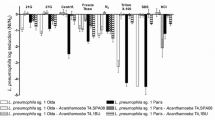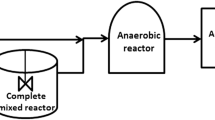Abstract
The aim of the study was to evaluate the response of two differentLegionella pneumophila strains with their 20 times subcultured passages, regarding VBNC induction and to test the effect of multiple subculturing on cell vulnerability in the presence of monochloramine. A freshly opened ofL. pneumophila ATCC 33152, a first subculture of environmental isolate ofL. pneumophila and the 20th subcultures of both strains were tested for survival in the presence of different doses of monochloramine (24 hours). Besides culture method, live-dead cells were visualised. It was found that multiple subcultured strains were significantly more susceptible to monochloramine and not capable of entering to VBNC state in comparison with freshly opened/isolated strains. Environmental isolate was survived at 2 ppm dose of monochloramine after 24 h, whereas 20th subculture of this strain failed to survive. Multiple subculturedL. pneumophila strains were lost their culturability and viability significantly. This phenomenon should be considered while working with laboratory strains. After monochloramine disinfection,L. pneumophila bacteria can completely lose their cultivability but do not lose viability, which remains responsible for serious outbreaks worldwide. Even after completely loosing cultivability, it is possible to find live cells in network water in the VBNC state.
Similar content being viewed by others
References
Alleron L., Frere J., Merlet N., Legube B. (2006). Monochloramine treatment induces Viable but Nonculturable (VBNC) state into biofilm and planktonicLegionella pneumophila populations. In: Cianciotto N., Eds,Legionella: State of the art 30 years after its recognition. ASM Press, Washington, DC, USA, pp. 533–536.
Bloomfield S.F., Stewart G.S., Dodd C.E., Booth I.R., Power E.G. (1998). The viable but non-culturable phenomenon explained? Microbiology, 144: 1–3.
Cavalcante S.C., Freitas R.S., Vidal M.S.M., Dantas K.C., Levi J.E., Martins J.E.C. (2007). Evaluation of phenotypic and genotypic alterations induced by long periods of subculturing ofCryptococcus neoformans strains. Mem. Inst. Oswaldo Cruz, 102: 41–47.
Dennis P.J.L. (1988). Isolation of legionellae from environmental specimens. In: Harrison T.G., Taylor A.G., Eds, Laboratory Manual forLegionella, J. Wiley & Sons, Chichester, USA, pp. 31–44.
Diederen B.M.W., Jong J.M.A., Aarts I., Peeters M.F., Zee A. (2007). Molecular evidence for the ubiquitous presence ofLegionella species in Dutch tap water installations. J. Water and Health, 5: 375–383.
Donlan R., Murga R., Carpenter J., Brown E., Besser R., Fields, B. (2002). Monochloramine disinfection of biofilm-associatedLegionella pneumophila in a potable water model system. In: Marre R., Kwaik Y.A., Fields B., Eds,Legionella, ASM Press, Washington DC, USA, pp. 406–410.
Flannery B., Gelling L.B., Vugia D.J., Weintraub J.M., Salerno J.J., Conroy M.J., Stevens V.A., Rose C.E., Moore M.R., Fields B.S., Beser R.E. (2006). ReducingLegionella colonization in water systems with monochloramine. Emerg. Infect. Dis., 12: 588–596.
Fontana C., Laratta E., Marino D., Pistoia E.S., Favalli C. (1997). Simple enzymatic method for rapid identification of aStaphylococcus aureus Subspeciesaureus biovar. Eur. J. Clin. Microbiol. Infect. Dis., 16: 689–692.
Hussong D., Colwell R.R., O’Brein M. (1987). ViableLegionella pneumophila not detectable by culture on agar media. Biotechnology, 5: 947–950.
Kool J.L., Carpenter J.C., Fields B.S. (1999). Effect of monochloramine disinfection of municipal drinking water on risk of nosocomial Legionnaires’ disease. Lancet, 353: 272–277.
Kuchta M., States S.J., McGlaughlin J.E., Overmeyer J.H., Wadowsky R.M., McNamara A. M.R., Wolford S., Yee R.B. (1985). Enhanced chlorine resistance of tap water-adaptedLegionella pneumophila as compared with agar medium-passaged saged strains. Appl. Environ. Microbiol., 50: 21–26.
McDougald D., Rice S.A., Weichart D., Kjelleberg S. (1998). Nonculturability: adaptation or debilitation? FEMS Microbiol. Ecol., 25: 1–9.
Moore M.R., Pryor M., Fields B., Lucas C., Phelan M., Besser R.E. (2006). Introduction of monochloramine into a municipal water system: impact on colonization of buildings byLegionella spp. Appl. Environ. Microbiol., 72: 378–383.
Rodriguez G.G., Phipps D., Ishiguro K., Ridgway H.F. (1992). Use of a fluorescent redox probe for direct visualization of actively respiring bacteria. Appl. Env. Microbiol., 58: 1801–1808.
Roszak D.B., Grimes D.J., Colwell R.R. (1984). Viable but nonre-convertable stage ofSalmonella enteritidis in aquatic systems. Can. J. Microbiol., 30: 334–338.
Skaliy P., Thompson T.A., Gorman W.G., Morris G.K., McEachern H.V., Mackel D.C. (1980). Laboratory studies of disinfectants againstLegionella pneumophila. Appl. Environ. Microbiol., 40: 697–700.
Søndergaard M., Danielsen M. (2001). Active bacteria (CTC+) in temperate lakes: temporal and cross-system variations. J. Plankton Res., 23: 1195–1206.
Steinert M., Emody L., Amann R., Hacker J. (1997). Resuscitation of viable but nonculturableLegionella pneumophila Philadelphia JR 32 byAcanthamoeba castellanii. Appl. Environ. Microbiol., 63: 2047–2053.
Türetgen I. (2004). Comparison of the efficacy of free residual chlorine and monochloramine against biofilms in model and full scale cooling towers. Biofouling, 20: 81–85.
Türetgen I., Cotuk A. (2006). Efficacy of monochloramine against surface-associatedLegionella pneumophila in Cooling Tower Model System. In: Cianciotto N., Ed.,Legionella: State of the Art 30 years after its Recognition. ASM Press, Washington, DC, USA, pp. 529–532.
Wullings B.A., Kooij D. (2006). Occurrence and genetic diversity of unculturedLegionella spp. in drinking water treated at temperatures below 15 °C. Appl. Environ. Microbiol., 72: 157–166.
Author information
Authors and Affiliations
Corresponding author
Rights and permissions
About this article
Cite this article
Turetgen, I. Induction of Viable but Nonculturable (VBNC) state and the effect of multiple subculturing on the survival ofLegionella pneumophila strains in the presence of monochloramine. Ann. Microbiol. 58, 153–156 (2008). https://doi.org/10.1007/BF03179460
Received:
Accepted:
Issue Date:
DOI: https://doi.org/10.1007/BF03179460




